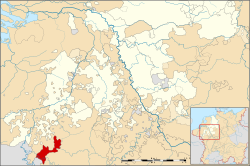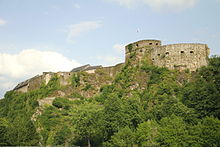- Duke of Bouillon
-
Duchy of Bouillon
Duché de BouillonState of the Holy Roman Empire
Fief of early modern France← 
1456? – 1794  →
→

Flag Coat of arms The Duchy of Bouillon as at 1560, shown within the Lower Rhenish–Westphalian Circle Capital Bouillon Government Principality Historical era Middle Ages - Ardennes lords of Bouillon by the 11th century - La Marck châtelains from 1415 - First style of Duke 1456 - Treaties of Nijmegen 1678 - Abolition of manorial
and feudal rights
26 May 1790- Ducal constitution 23 March or 1 May 1792 - Proclamation of the
Republic
24 April 1794- Annexed to France 26 October 1795
(4 Brumaire, Year IV)Area - 1790 230 km2 (89 sq mi) Population - 1790 est. 12,000 Density 52.2 /km2 (135.1 /sq mi) Today part of  Belgium
BelgiumThe Duke of Bouillon (French: duc de Bouillon) is a title of nobility. Until the nineteenth century, the Duke of Bouillon was the ruler of the semi-sovereign Duchy of Bouillon (French: duché de Bouillon), a small state located between Luxembourg, Champagne, and the Three Bishoprics and centered on Bouillon.
Contents
History of the Duchy of Bouillon
Frankish Kingdom
(5th to 10th century)Frisian Kingdom
(600-734)Carolingian Empire after 800 West Francia ("France") Independent Kingdom of Middle Francia (Lotharingia)
(843–870)Flanders and Lotharingia in Kingdom of West Francia
(870–880)
County of Flanders
(862–1384)
and other principalities
(10th–14th centuries)Kingdom then Duchy of Lotharingia in East Francia ("Germany")
(880-1190)
Prince-Bishopric
of Liège
(980-1794)

Duchy of Bouillon
(988-1795)

Imperial Abbey of Stavelot-Malmedy
(1138-1795)
Duchy of Brabant
(1183-1430)
and other principalities
(10th–15th centuries)
County/
Duchy of
Luxembourg
(963–1443)
County of Holland
(880-1432)
and other principalities
(10th–15th centuries)
Burgundian Netherlands
(1384–1482)
Habsburg Netherlands
(Seventeen Provinces)
(1482–1581)
Spanish Netherlands
(Southern Netherlands)
(1581–1713)
Dutch Republic
(1581–1795)
Austrian Netherlands
(Southern Netherlands)
(1713–1795)
Liège Revolution
(1789–1792)
United States
of Belgium
(1790)

Part of the
French Republic
(1795–1804)
and the
French Empire
(1804–1815)
Batavian Republic
(1795–1806)
Kingdom
of Holland
(1806–1810)
United Kingdom of
the Netherlands
(1815-1830)
Kingdom of Belgium
(since 1830)
Gr Duchy Luxembourg
(personal union)
Kingdom of
the Netherlands
(since 1830)
Gr Duchy Luxembourg
(since 1890)The Duchy of Bouillon's origins are unclear. The first reference to Bouillon Castle comes in 988 and by the 11th century, Bouillon was a freehold held by the House of Ardennes, who styled themselves Lords of Bouillon. On the death of Godfrey III, Duke of Lower Lorraine in 1069, Bouillon passed to his nephew, Godfrey of Bouillon. In 1095, Godfrey of Bouillon sold Bouillon to the Prince-Bishop of Liège, Otbert of Liège in order to finance his participation in the First Crusade.
The Prince-Bishop of Liège granted the châtellenie of Bouillon to the House of La Marck in 1415. In 1456, Louis de Bourbon, Bishop of Liège became the first individual to style himself "Duke of Bouillon". In 1482, the Châtelain of Bouillon, William de La Marck, ordered the assassination of Louis de Bourbon, Bishop of Liège in a plot to install his son, Jean de la Marck, as Prince-Bishop of Liège. This plot proved unsuccessful: John of Hornes was elected as successor of Louis de Bourbon as Prince-Bishop of Liège. John of Hornes then fought a war with William de La Marck that ended with the Treaty of Tongeren, signed May 21, 1484, with the de la Marck family relinquishing its claim on Liège, though the de la Marcks retained Bouillon Castle as a pledge. Robert II de la Marck began calling himself "Duke of Bouillon" in 1492, but in 1521, the Prince-Bishop of Liège, Erard de La Marck (a fellow member of the House of La Marck), with the backing of the troops of Charles V, Holy Roman Emperor, managed to regain Bouillon for the Prince-Bishopric.
Robert Fleuranges III de La Marck began styling himself "Duke of Bouillon" in 1526 and all of his successors maintained the right to this title. During the Italian War of 1551–1559, Bouillon was occupied by the forces of Henry II of France to keep them free from Habsburg influence, but Henry II confirmed Robert IV de la Marck as Duke of Bouillon.
From 1560 to 1642, the Dukes of Bouillon were also the rulers of the independent Principality of Sedan.
With the death of Charlotte de La Marck in 1594, the duchy and the title passed to her husband Henri de La Tour d'Auvergne, Duke of Bouillon and thereafter became the possession of the House of La Tour d'Auvergne. France again invaded Bouillon in 1676 during the Franco-Dutch War, but Godefroy Maurice de La Tour d'Auvergne remained Duke of Bouillon. From this point on, although the Duchy of Bouillon was technically still a part of the Holy Roman Empire, it was in actuality a French protectorate. This state of affairs was confirmed by the 1678 Treaties of Nijmegen.
In the wake of the French Revolution, the French Revolutionary Army invaded the Duchy of Bouillon in 1794, creating the short-lived Republic of Bouillon. In 1795, Bouillon was annexed to France.
At the Congress of Vienna, in 1815, the title of "Duke of Bouillon" was restored to Charles Alain Gabriel de Rohan. The Duchy of Bouillon, however, was annexed to the Grand Duchy of Luxembourg, then in personal union with the Kingdom of the Netherlands, becoming part of the Kingdom of the Belgians in 1830.
Geography of the Duchy of Bouillon
The Duchy of Bouillon was a sovereign duchy in many ways until 1795, but it was very tiny, the smallest territory within the Holy Roman Empire.[dubious ] In 1789, it had a population of 2,500. The largest town was Bouillon, situated on the Semois. It also consisted of the surrounding villages: Sugny, Corbion, Alle, Rochehaut, Ucimont, Botassart, Sensenruth, Noirefontaine, Gros-Fays, Fays-les-Veneurs, Bertrix, Carlsbourg, Paliseul, Jehonville, Opont, Anloy, Porcheresse, Gembes, Gedinne, Sart-Custinne, and Tellin.
Bouillon is located in a Walloon-speaking region.
List of Dukes of Bouillon
House of La Marck, ?–1588
Picture Name Father Birth Marriage Became duke Death Spouse 
Robert I de La Marck Jean de La Marck 1430 15 June 1446 ?
Bouillon raised to a DuchyFebruary 1487 Jeanne de Marley 
Robert II de La Marck Robert I 1465 25 December 1490 February 1487
fathers death1536 Catherine de Croÿ 
Robert Fleuranges de La Marck Robert II 1491 1 April 1510 March 1667
fathers death21 December 1536 Guillemette of Saarbrücken, Countess of Braine 
Robert IV de La Marck Robert Fleuranges 5 January 1512 1 March 1539 21 December 1536
fathers death15 February 1556 Françoise de Brézé, Countess of Maulevrier 
Henri Robert de La Marck Robert IV 7 February 1540 7 Feb 1558 15 February 1556
fathers death2 December 1574 Françoise de Bourbon 
Charlotte de La Marck
suo jureHenri Robert 5 November 1574 19 November 1591 2 December 1574
fathers death15 May 1594 Henri de La Tour d'Auvergne Picture Name Father Birth Marriage Became duke Death Spouse House of La Tour d'Auvergne, 1588–1802
Picture Name Father Birth Marriage Became duke Ceased to be duke Death Spouse 
Henri de La Tour d'Auvergne François de La Tour d'Auvergne 28 September 1555 19 November 1591 15 May 1594
first wife's death25 March 1623 Charlotte de La Marck 15 April 1595 Elisabeth of Nassau 
Frédéric Maurice de La Tour d'Auvergne Henri 22 October 1605 2 January 1634 25 March 1623
fathers death9 August 1652 Eleonora Catharina Febronis van den Bergh 
Godefroy Maurice de La Tour d'Auvergne Frédéric Maurice 21 June 1636 19 April 1662 9 August 1652
fathers death26 July 1721 Marie Anne Mancini 
Emmanuel Théodose de La Tour d'Auvergne Godefroy Maurice 1668 1 February 1696 26 July 1721
fathers death17 April 1730 Marie Armande Victoire de La Trémoille 4 January 1718 Louise Françoise Angélique Le Tellier 21 March 1725 Louise Henriette Françoise de Lorraine 
Charles Godefroy de La Tour d'Auvergne Emmanuel Théodose 16 July 1706 2 April 1724 17 April 1730
fathers death24 October 1771 Maria Karolina Sobieska 
Godefroy de La Tour d'Auvergne Charles Godefroy 26 January 1728 27 November 1743 24 October 1771
fathers death3 December 1792 Louise de Lorraine 
Jacques Léopold de La Tour d'Auvergne Godefroy 15 January 1746 17 July 1766 3 December 1792
fathers death1794
Bouillon absorbed into the French First Republic7 February 1802 Hedwig of Hesse-Rotenburg Picture Name Father Birth Marriage Became duke Ceased to be duke Death Spouse House of Rohan, since 1816
In 1816, the Congress of Vienna restored the title of "Duke of Bouillon", giving it on Charles Alain Gabriel de Rohan, son of Marie Louise de La Tour d'Auvergne, who was the daughter of the former duke Charles Godefroy de La Tour d'Auvergne.
Picture Name Father Birth Marriage Became duke Death Wife 
Charles Alain Gabriel
[1][2][3]Henri Louis, Prince of Guéméné
(Rohan)18 January 1764 29 May 1781 1816
accession24 April 1836 Louise Aglae de Conflans d'Armentieres 
Louis Victor Mériadec
[1][2][3][4]Henri Louis, Prince of Guéméné
(Rohan)1766 24 April 1836
accession1841 Berthe de Rohan 
Camille Philippe Joseph Idesbald
[1][2][3]Charles-Louis-Gaspard de Rohan-Rochefort
Adopted by Louis Victor Mériadec19 December 1801 28 May 1826 1846
accession13 September 1892 Adelheid zu Löwenstein-Wertheim-Rosenberg 
Alain Benjamin Arthur
[1][2][3][5][6]Arthur de Rohan (1826–1885), son of Camille Philippe 8 January 1853 10 October 1885 13 September 1892
accession24 February 1914 Johanna of Auersperg 
Alain Anton Joseph Adolf Ignaz Maria
[1][2][3][5][6]Alain Benjamin Arthur 26 Jul 1893 29 September 1921 24 February 1914
uncles death17 March 1975 Margarethe von Schönburg-Hartenstein 
Karl-Alain Albert Maria
[1][2][3][5][6]Alain Anton 1934 5 October 1963 2 September 1976
accession2008 Ingeborg Irnberger 
Albert Marie
[1][2][3][5][6]Alain Anton 12 May 1936 2008
accessionIncumbent Picture Name Father Birth Marriage Became duke Death Wife See also
- Duchess of Bouillon
- Prince of Sedan
References and notes
The generations start from the Henri de La Tour d'Auvergne, first sovereign Duke of Bouillon1st Generation Frédéric Maurice, Duke of Bouillon · Henri, Viscount of Turenne2nd Generation Godefroy Maurice, Duke of Bouillon · Frédérique Maurice, Count of Auvergne · Emmanuel Théodose, Cardinal de Bouillon
3rd Generation Louis Charles, Prince of Turenne · Emmanuel Theodose, Duke of Bouillon · Eugene Maurice, Prince of Château-Thierry · Frédéric Jules, Prince of Auvergne · Louis Henri, Count of Évreux · Frédéric Godefroy, Marquis of Berg · Emmanuel Maurice, Le Bailly d'Auvergne · Henri Oswald, Cardinal, Archbishop of Vienne · François, Prince of Limeuil · Louis Frédéric · François Egon, Count of Auvergne · Frédéric Constantin, Count of Oliergues
4th Generation Godefroy Maurice, Prince of Turenne · Frédéric Maurice Casimir, Prince of Turenne · Charles Godefroy, Duke of Bouillon · Godefroy Girault, Duke of Château-Thierry
5th Generation Godefroy, Duke of Bouillon
6th Generation Jacques Léopold, Duke of Bouillon · Charles Louis Godefroi, Prince of Auvergne · Louis Henri, Duke of Albret
The generations start from the Henri de La Tour d'Auvergne, first soveriegn Duke of Bouillon1st Generation Louise · Marie, Duchess of Thouars · Juliane Catherine, Countess of Roucy · Élisabeth, Marquise of Duras · Henriette Catherine, Marquise of La Moussaye · Charlotte2nd Generation Élisabeth, Duchess of Elbeuf · Louise Charlotte · Amalie · Hypolite · Mauricette Febronie, Landgravine of Leuchtenberg · Élisabeth Eléonore · Louise Emilie · Marie Anne · Therese Henriette3rd Generation Marie Élisabeth · Louise Julie, Princess of Montbazon · Maria Henriette, Hereditary Princess of Sulzbach4th Generation Armande, Princess of Epinoy · Marie Madeleine · Marie Hortense Victoire, Duchess of Thouars · Anne Marie Louise, Princess of Soubise · Marie Charlotte, Princess of Beauvau · Marie Louise Adelaïde5th Generation 6th Generation noneCategories:- Former principalities
- Former polities in the Netherlands
- States of the Holy Roman Empire
- States and territories established in the 15th century
- States and territories disestablished in 1794
- Dukes of Bouillon
- House of La Marck
- House of la Tour d'Auvergne
- House of Rohan
- French nobility
Wikimedia Foundation. 2010.



